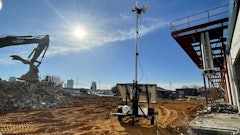ConstructConnect’s latest (Q4) forecast lowers the year-on-year projection of 2016 total construction starts in the U.S. to 6.2% from 7.9% in its previous (Q3) report. The 2017 versus 2016 outlook, however, has been lifted to 6.8% from 6.2% according to ConstructConnect's recent quarterly report.
The forecast which combines ConstructConnect's proprietary data with macroeconomic factors and Oxford Economics econometric expertise, shows non-residential construction will benefit from four trends:
- Ongoing shortages in office space
- An aging population that will drive health care needs
- New and repair work on essential infrastructure
- A gradual firming up of energy prices that will be a spur to engineering/civil investment
“ConstructConnect’s latest forecast assessment is being carried out at a time of extraordinary uncertainty. Still unknown is whether or not the soon-to-be-decided presidential election result will provide a more favorable framework for investment decision-making," said Alex Carrick, ConstructConnect's chief economist. "The most recent comments from the Federal Reserve indicate it is continuing to waffle about its interest rate intentions."
The report states nonresidential construction starts so far in 2016 have been better than expected, led by strength in the private office building, parking garage, hospital and other medical facility type-of-structure categories. Residential starts to-date this year have been weaker than anticipated, partly due to uncertainty on account of the election.
"And while U.S. economic growth is maintaining forward momentum, the pace is slower than in previous expansions, and the prolonged length of the upturn is creating worry about how much longer it can be sustained,” stated Carrick.
According to the report, some factors are in place that will be supportive of homebuilding, including rising incomes, low mortgage rates and plenty of pent-up demand. Single-family starts are forecast to grow at roughly twice the pace of multi-family starts over much of the forecast period out to 2020. Weaker than expected new residential construction has led to 2016’s total starts forecast being revised down to 6.2% from 7.9% in the previous quarter.
Nonresidential starts in 2016, however, will be stronger than projected this past summer, 6.6% compared with 5.3%. The annual volume of commercial and institutional starts this year will be almost the same, at slightly over $100 billion each. This year has been a challenging year for industrial starts (-25.7% year over year), but 2017 will see improvement (11.1%). For 2017, total starts will be 6.8%, which is higher than the 6.4% figure projected a quarter ago; 2018 will also be quite respectable at 6.2%.
A resolution of the uncertainty arising from the presidential election will provide owners contemplating investments with a more stable economic framework for decision making.





![[Video] 2017 Economic Outlook - Eli Lustgarten](https://img.forconstructionpros.com/files/base/acbm/fcp/image/2016/12/default.585c1ea926c20.png?auto=format%2Ccompress&fit=crop&h=167&q=70&w=250)










